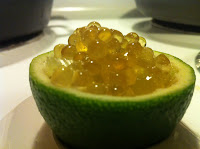But if the sous vide is the Ying, a good chamber vacuum sealer is the Yang.
Without a chamber, you can't vacuum anything with liquids. Also, you're not able to use techniques that rely on the compression (think watermelon) or degassing (think un-bubbled sodium alginate solutions) effects of the vacuum.
Unfortunately, retail chamber vacs ($1k-$5k) make retail sous vide machines look cheap..... so it was time to build one.
Main Parts List:
- 10' x 10" x 1/4" Cold Rolled Steel Sheet ($100)
- 2 Stage HVAC Vacuum Pump With R12 (Freon) Inlet ($150)
- 5mm Impulse Sealer ($50)
- 12" R12 - R12 Hose ($10)
- Vacuum Gauge (or boost/vacuum gauge) ($10 ebay)
- 14mm to R12 Adapter
- 1/4" x 1/2" x 10' Weatherstripping
- 1/4" NPT Ball Valve
- 1/4" Male to Male NPT Coupler
- Large Gauge Extension Cord
- 12-24 x 2" Bolts with nuts
- Crimp On Electrical Connectors
- 1/4" OD PVC Pipe
- JB Weld - Quick Set
Step Zero- Find someone that can weld!
For me, that came by way of my friend Seth (who graciously helped with this crazy project).
He used a 110v MIG welding machine, Cutting Torch and an 8" angle grinder for the majority of the work.
Step One
He cut the 10" Steel at 4x 19" (sides, top and lid), 2x 10" (end sides) and one remainder piece for the bottom. Then he used the angle grinder to put a 45 degree edge on all four of the "side" pieces. Using the torch, he cut a huge hole in the "top" piece where it left only 1" border on all sides.
Step Two
Using magnetic 90 degree wedges, he welded on the long sides to the bottom and then the short sides.
Then he welded the top "cut out piece" to the top of the box.
Step Three
Drill and Tap holes for the suction ("14MM" used 12.5 x 1.5mm tap), release( 1/4" NPT Tap) and gauge (1/8" NPT Tap).
Note: The size for the drill bit will be less than the size of the tap. I had a bit set in 64ths from 1/16" to 1/2" and it did the trick. Use teflon tape and screw in those three items.
Drill two holes that will fit your PVC pipe through.
Step Four
I used the JB Weld to make airtight insulators around the 2" bolts.
The picture in this case is worth 1000 words.
I then stuck those connectors through the box and used the JB Weld on the PVC into the box.
Step Five
Using the weatherstripping, I applied one long piece, starting in the middle of the long side of the box. I made the radius of the corners as large as I could. I overlapped the end by a smidge and pressed it against the starting edge. This, somehow, seals it just fine.
Step Six
I hooked up the vacuum pump with the R12 hose to the box.
Step Seven
I put an eye bolt into the swing arm of the sealer so I could tie it down with string.
I placed the impulse sealer into the box and plugged it into the sealed power connections.
The sealer is set at 8 of 10 power.
A Note on Bags
"Real" chamber vacuum bags work best. The bags for an external vacuum sealer were hit or miss.
Using the Vacuum
Vacuuming is pretty easy.
Prepare the bag like normal.
Place in the sealer's opening, lower the arm and tie with string.
Place the lid on the box, close the relief valve and fire up the pump.
It takes about 3 minutes to get most of the air out and up to 10 to make a huge vacuum.
This is due in large part to the size of the box. It's pretty big compared to some of the real chamber vacuums.




